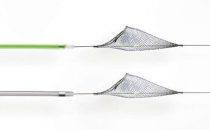New findings from the GARY (German Aortic Valve Registry) registry show that intermediate-risk patients with severe aortic stenosis presented significantly higher mortality at 1 year when treated with transcatheter aortic valve replacement (TAVR) rather than with conventional surgery. Results reflect everyday realities, which might include various bias tipping the scales towards one strategy or the…
Less than 20% of patients that could benefit from TAVR are receiving it
The introduction of transcatheter aortic valve replacement procedures (TAVR) seems to have increased the number of elderly patients hospitalized with severe aortic stenosis, as well as the number of interventions. However, less than one fifth of patients over 85 are intervened, according to a Canadian registry. Given the significant difference in mortality with TAVR,…
TAVR: The Need for a Pacemaker Is Associated with Mortality
Courtesy of Dr. Carlos Fava. After a transcatheter aortic valve replacement (TAVR), the incidence of permanent pacemaker (PPM) implantation ranges from 6% to 30% in different studies, depending on the valve type used. This is due to trauma, ischemia, haemorrhage, and atrioventricular node and infranodal tissue oedema, provoking ventricular dyssynchrony similar to that caused by…
Post-TAVI Definite Pacemaker: How Harmless Is It?
Courtesy of Dr. Carlos Fava. Transcatheter aortic valve replacement (TAVR) has shown ample benefit in different groups, but one of its drawbacks continues to be the need for permanent pacemaker (PPM), which ranges between 5 and 30%. Its long term impact in terms of mortality is still controversial, since some studies associate it with…
Valve Thrombosis After TAVR: Larger-Diameter Valves and No Warfarin as Predictors
There are limited data on the incidence, clinical implications, and predisposing factors of valve thrombosis in patients who underwent transcatheter aortic valve replacement (TAVR). This study aimed at determining such information through multislice computed tomography (CT). This trial included 460 consecutive patients who underwent TAVR with a balloon-expandable Edwards Sapien XT or Sapien 3 (Edwards Lifesciences,…
TAVR in Pure Aortic Regurgitation Is Associated with Lower Mortality Rates
This study summarizes all available evidence on transcatheter aortic valve replacement (TAVR) for the treatment of native pure aortic regurgitation. Surgical replacement is the standard of care for pure aortic regurgitation. However, there are many reports of cases and small studies in which high-risk patients with pure aortic regurgitation were treated with TAVR. …
Transcarotid TAVR Safety: Local or General Anesthesia?
Courtesy of Dr. Agustín Vecchia. Early transcatheter aortic valve replacement (TAVR) was characterized by high vascular complication rates associated to elevated device diameter (e.g. 22-24 Fr. in the first PARTNER) and less operator experience typical of new techniques. This study shows the progress of TAVR field in these last years, the experience gained by…
Embolic Protection Devices Reduce the Risk of New Lesions During TAVR
The aim of this study was to investigate the efficacy and safety of cerebral protection devices during transcatheter aortic valve replacement (TAVR). All randomized controlled trials investigating the efficacy of cerebral protection devices during TAVR are relatively small and lack statistical power for definitive conclusions. That is the reason why this systematic review…
TAVI May Improve Cognitive Function in Patients with Prior Deterioration
This work studies cognitive evolution after transcatheter aortic valve implantation (TAVI). Previous smaller studies reported conflicting results on cognitive function after TAVI. This study prospectively included 229 patients who were ≥70 years old, had undergone TAVI and were assessed using the Mini Mental State Examination before and 6 months after the procedure. Cognitive deterioration or improvement was…
Cerebral Protection in TAVR: Studies Presented at London Valves
SENTINEL One of the new devices assessed at London Valves was Sentinel, which is made up of two independent filters. The larger filter is deployed in the brachiocephalic trunk, and the smaller filter is deployed in the left common carotid artery. The study included 22 patients and the device was deployed successfully in 20 of them…
Percutaneous Device Closure of PVL: An Alternative to Surgery
Paravalvular Leak (PVL) occurs in 5 to 17% of patients undergoing surgical valve replacement. Percutaneous device closure of PVL represents an alternative to repeat surgery. All centers in UK and Ireland performing percutaneous PVL closure delivered their data to the UK PVL registry. Data were analyzed for factors associated with mortality and major cardiovascular…










